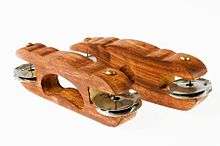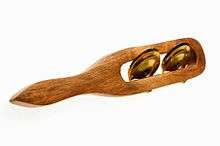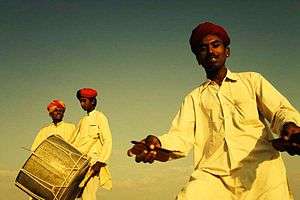Khartal



A khartal or kartal is a percussion instrument of India.
Khartal is an ancient instrument mainly used in devotional / folk songs. It has derived its name from Hindi words ‘kara’ means hand and ‘tala’ means clapping. This wooden clapper is a Ghana Vadya which has discs or plates that produce a clinking sound when clapped together. It falls under the class of idiophones of self-sounding instruments that combine properties of vibrator and resonator.
Usually made wood or metal, a khartal player will hold one ‘male’ and ‘female’ khartal in each hand. The ‘male’ khartal is usually thicker and is held with the thumb while the ‘female’ khartal is usually thinner and is mainly balanced on the ring finger, which represents the fire element. It is associated with the sun and the root chakra. Its force provides staying power, stamina, and the power to be assertive.
A pair of wooden castanets with bells attached to them was the earliest form of the khartal. These pieces of wood are not connected in any way. However, they can be clapped together at high speeds to make rapid, complex rhythms. Aside from being an excellent accompaniment instrument, khartal is the most portable percussion instrument in the world.
1. Kartals (blocks). It consists of a pair of wooden blocks with jingles or crotales (kartals mean crotales). One pair is used in one hand of the musician. These pieces can be clapped together at high speeds to make fast complex beats.
2. Kartals (small sheets). It consists of a pair of thin, hard wooden pieces similar to the percussion bones (instrument). These are used in Rajasthan.
3. Kartals (cymbals). The karatalas are small cymbals, also known as manjeera. These are used in devotional chants.
In Maharashtra Kartals are better known as Chipaḷyā. It is commonly used in religious song like Kirtans and Bhajans.
In Telugu language, the word Karatāḷa Dhvani is most commonly used for sound produced from clapping hands.[1]
External links
- "Khartal" The Official Site
- Video con kartals (small sheets)
- Video con kartals (blocks)
- Video con kartals (cymbals)
References
- Mehta, Siddharth (2013). Art of Khartal. Surya.
- Beck, John (1994). Encyclopedia of Percussion. Garland. ISBN 978-0-8240-4788-7.